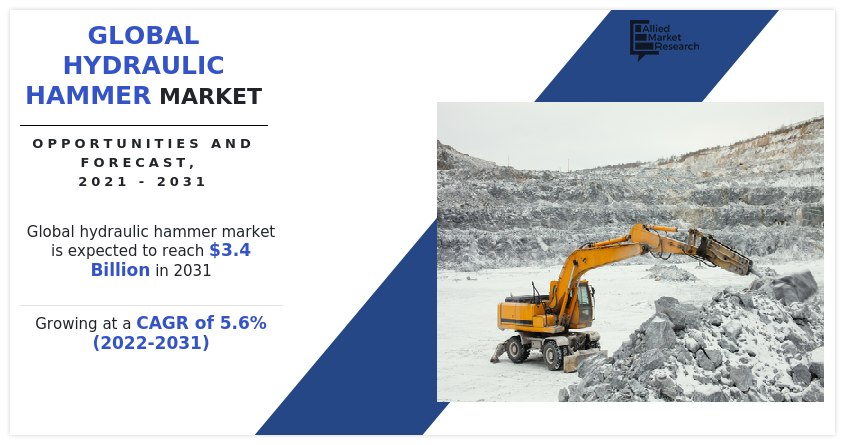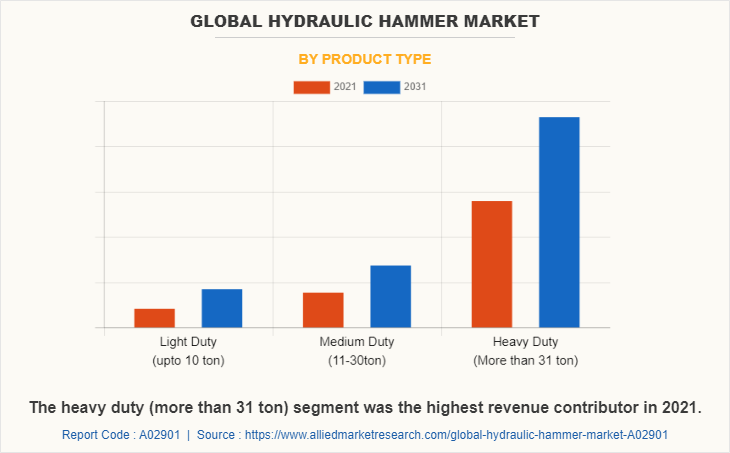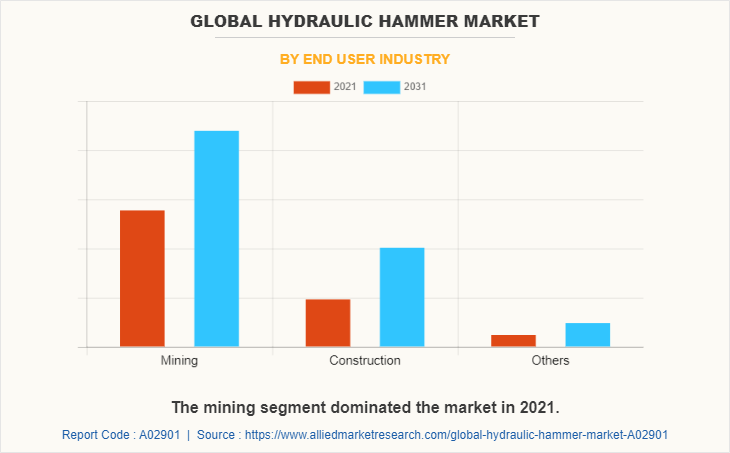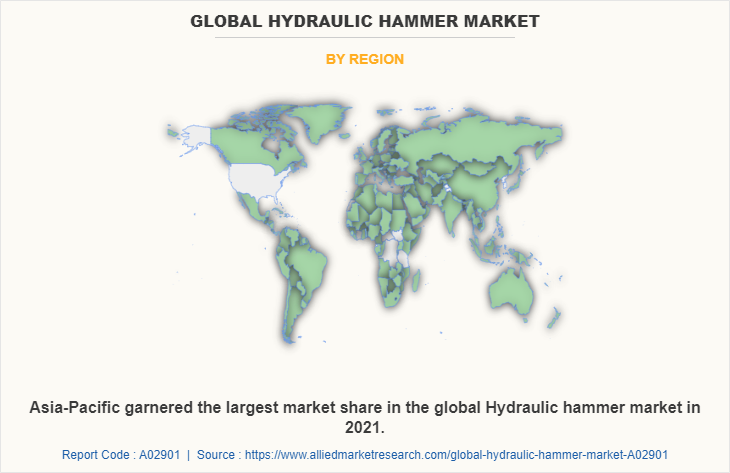Global Hydraulic Hammer Market Research, 2031
The global hydraulic hammer market size was valued at $2 billion in 2021, and is projected to reach $3.4 billion by 2031, growing at a CAGR of 5.6% from 2022 to 2031.

Market Dynamics
Hydraulic hammer is a construction machine that consists of a powerful hammer, which is fitted to an excavator for demolishing hard rocks and structures. It is powered by an auxiliary hydraulic system from the excavator, which is fitted with a foot-operated valve for this purpose. It applies high pressure from its small canister which has pressurized hydraulic oil stored in it. Hydraulic hammer comes in different power capacity which includes, light duty {up to 10 ton}, medium duty {11-30ton}, and heavy duty {more than 31 ton}. Hydraulic hammers are used in mining and construction sectors.
Increase in infrastructure, residential, and commercial construction has led to surge in demand for hydraulic hammer. Moreover, rise in population and increasing demand for roads, highways, bridges, and tunnels are expected to drive the hydraulic hammer market during the forecast period. In addition, high productivity, high percussive performance, and energy recovery can increase the output per shift and lower energy and fuel consumption are few advantages of hydraulic hammer which are driving the market growth. Hence, various key players are focusing on manufacturing advanced hydraulic hammers for construction and mining applications. For instance, in September 2021, Hammer SRL has launched the Hammer SB 55 at the Construction & Quarry Machinery Show – CQMS 21'. The new hammer offers more power, less vibrations and maintenance, long lasting of the nitrogen charge, silenced body, and Monoblock body without tie rods. Moreover, rise in government investments in infrastructure projects and mining sectors are providing lucrative growth in the market.
Increase in population in developing economies such as China, India, and the U.S. has led to rapid urbanization, which is expected to boost development of the residential sector and increase demand for hydraulic hammer. According to the United Nations (UN), around 68% of the world population is expected to live in urban areas by 2050. This is expected to result in increase of construction activities in residential, infrastructure and non-residential around the globe. Such factors will drive the growth of hydraulic hammer market forecast period.

On the basis of product type, the heavy-duty (more than 31 ton) segment registered highest revenue in 2021. Heavy duty hydraulic hammers are widely used in demolition of large structure. They break up the surface and get the job done fast and effectively when operated by a trained technician. These hydraulic hammers are highly efficient and saves a lot of manpower.

On the basis of end user industry, the mining segment generated highest revenue in 2021. This is attributed to rising government investments in mining of minerals, coal, and metal. For instance, in October 2020, Russia government has announced an investment of $1.5 billion in rare earth mining and infrastructure as it boasts around twelve million tons of the materials. Such factors will increase the demand for hydraulic hammer and thus will drive the market growth.
The novel coronavirus (COVID-19) rapidly spread across various countries and regions in 2019, causing an enormous impact on the lives of people and the overall community. It began as a human health condition and has now become a significant threat to global trade, economy, and finance. The COVID-19 pandemic halted production of many products in the hydraulic hammer market, owing to lockdowns. Furthermore, the number of COVID-19 cases is expected to reduce in the future with the introduction of the vaccine for COVID-19 on the market. This has led to the reopening of hydraulic hammer companies at their full-scale capacities. This is expected to help the market recover by the end of 2022. After COVID-19 infection cases begin to decline, hydraulic hammer manufacturers must focus on protecting their staff, operations, and supply networks to respond to urgent emergencies and establish new methods of working.
Segmental Overview
The global hydraulic hammer market is segmented into Product Type, Business and End User Industry.
By type, the market is categorized into light duty (up to 10 ton), medium duty (11-30ton), heavy duty (more than 31 ton). Depending on business, it is fragmented into OEM and aftermarket.
On the basis of end user industry, it is categorized into mining, construction, and others. Region-wise, the market is analyzed across North America, Europe, Asia-Pacific, and LAMEA.

Asia-Pacific dominated the market in 2021, accounting for the highest hydraulic hammer market share, and is anticipated to maintain this trend throughout the forecast period. This is attributed due to expansion of mining sector, urbanization, industrialization and in countries such as India, China, and Japan. Moreover, increasing government investment in infrastructure development is accelerating the hydraulic hammer market growth in the region. For instance, National Highways Authority of India has announced plans to construct 25,000 kilometers of national highways in 2022-23 at a pace of 50 km per day. Thus, all such factors are expected to drive the hydraulic hammer market growth in Asia-Pacific.
Competition Analysis
Key companies profiled in the hydraulic hammer industry include Atlas Copco, Brokk Global, Deere & Company, Dong Myung Topa Co., Furukawa Co Ltd., Hammer Europe, Hyundai Everdigm, Indeco North America, J C Bomford Excavators Ltd., Montabert, MSB Corporation, NPK Construction Equipment, Nuosen Machinery, Sandvik, Soosan Heavy Industries Co., Stanley Infrastructure and Toku Pneumatic Co.
Key Benefits For Stakeholders
- This report provides a quantitative analysis of the market segments, current trends, estimations, and dynamics of the global hydraulic hammer market analysis from 2021 to 2031 to identify the prevailing global hydraulic hammer market opportunities.
- The market research is offered along with information related to key drivers, restraints, and opportunities.
- Porter's five forces analysis highlights the potency of buyers and suppliers to enable stakeholders make profit-oriented business decisions and strengthen their supplier-buyer network.
- In-depth analysis of the global hydraulic hammer market segmentation assists to determine the prevailing market opportunities.
- Major countries in each region are mapped according to their revenue contribution to the global market.
- Market player positioning facilitates benchmarking and provides a clear understanding of the present position of the market players.
- The report includes the analysis of the regional as well as global hydraulic hammer market trends, key players, market segments, application areas, and market growth strategies.
Global Hydraulic Hammer Market Report Highlights
| Aspects | Details |
| Market Size By 2031 | USD 3.4 billion |
| Growth Rate | CAGR of 5.6% |
| Forecast period | 2021 - 2031 |
| Report Pages | 275 |
| By Product Type |
|
| By Business |
|
| By End User Industry |
|
| By Region |
|
| Key Market Players | Furukawa, Atlas Copco, Volvo, Caterpillar, Sandvik, Rammer, Breaker Technology Inc, MKB(KONAN), John Deere, Stanley Hydraulics, soosan heavy industries, Nuosen Machinery, Indeco, MSB, Everdigm, Miller UK, Montabert |
Analyst Review
The hydraulic hammer market is mainly driven by increase in infrastructural development such as roads, highways and bridges by governments, majorly in developing countries such as India, U.S., China and Germany. In addition, expansion of mining sector is another factor that drives growth of the hydraulic hammer market. Moreover, mining segment registered highest revenue in 2021, due to increasing government investments in mining of coal, metals, and minerals. However, lack of skilled & qualified operators is projected to hinder the market growth. Moreover, decrease in new construction activity is one of the factors that can negatively impact the market growth.
Major companies in the market have adopted strategies such as business expansion, product launch, acquisition, and partnership to offer better products and services to customers in the hydraulic hammer market. For instance, in April 2022, UK Prime Minister Boris Johnson officially opened JCB’s newest factory in India as the company strengthens its global manufacturing presence. A $129 million investment plant in Gujarat, which is anticipated to fabricate parts for global production lines. The new factory is located in Vadodara near the port city of Surat on the West Coast of India. Such factors drive the hydraulic hammer market growth.
The global Hydraulic hammer market size was valued at $1.9 billion in 2021.
The global Hydraulic hammer market size is projected to reach $3.4 billion by 2031.
An increase in construction and infrastructure activities in developed nations and rise in demand for coal, metal, and minerals are accelerating the hydraulic hammer market growth.
Asia-Pacific is the largest regional market for Global Hydraulic Hammer.
Mining is the leading end-user segment of the Global Hydraulic Hammer Market.
The company profile has been selected on factors such as geographical presence, market dominance (in terms of revenue and volume sales), various strategies and recent developments.
Lack of skilled & qualified operators and decrease in new construction activity are the Global Hydraulic Hammer market effecting factors.
The product launch is key growth strategy of Hydraulic Hammer industry players.
Loading Table Of Content...



